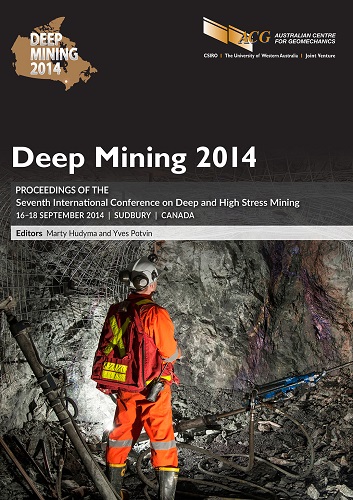Assessment of stope sequence alternatives in a diminishing ore pillar

|
Authors: Shnorhokian, S; Mitri, HS; Moreau-Verlaan, L |
DOI https://doi.org/10.36487/ACG_rep/1410_32_Shnorhokian
Cite As:
Shnorhokian, S, Mitri, HS & Moreau-Verlaan, L 2014, 'Assessment of stope sequence alternatives in a diminishing ore pillar', in M Hudyma & Y Potvin (eds), Deep Mining 2014: Proceedings of the Seventh International Conference on Deep and High Stress Mining, Australian Centre for Geomechanics, Perth, pp. 471-484, https://doi.org/10.36487/ACG_rep/1410_32_Shnorhokian
Abstract:
One of the primary mine planning abilities of numerical models is their assessment of stope sequence alternatives in terms of the redistribution of mining-induced stresses and the amount of rock face displacements in each of them. The models used for these studies are large and complex in nature as they need to replicate the entire orebody within which the stope sequence is being planned, in addition to the surrounding rock mass. In this paper, a case study is conducted at Vale’s Garson Mine for the stope sequence options of mining in Orebody #1 Shear West, which will result in a central diminishing ore pillar before final extraction. A mine-wide numerical model is first constructed in FLAC3D and calibrated based on an in situ stress measurement point on 4900L (1,495 m) such that the values read in the field are correlated to those generated by the model. The historical stope sequence followed at the mine is then replicated between the years 2001 and 2011, which is when mining is planned to commence between the levels of interest in #1 Shear West. Extraction is planned from both the eastern and western sides of the orebody, and the default sequence is considered to alternate between the two in each successive step as they move towards the diminishing ore pillar. Using the brittle shear ratio – the relationship between the differential stress (sigma 1 to sigma 3) and unconfined compressive strength of intact rock – and volumetric analysis, the planned stope sequence is assessed within the diminishing ore pillar. A threshold of 0.7 is considered as indicative of ore at risk based on the literature and Vale guidelines. A second sequence alternative, in which extraction in the east is accelerated thrice, is also considered and compared with the planned one. A new stope sequence planning tool is introduced to visually and quantitatively compare amongst the two sequences. It is shown that by using the planning tool, the volume of unmined ore (of operational and economical interest) and the volume of ore at risk (of ground control interest) can be quantitatively estimated at any given mining step. Finally, variations in rock mass properties based on laboratory results and borehole logs are considered to assess their effect on the volume of ore at risk in the alternative sequence.
References:
Castro, LAM 1996, ‘Analysis of Stress-Induced Damage Initiation Around Deep Openings Excavated in a Moderately Jointed Brittle Rock Mass’, PhD thesis, University of Toronto, Toronto.
Castro, LAM, Bewick, RP & Carter, TG 2012 ‘An Overview of Numerical Modelling Applied to Deep Mining’, in R Azevedo (ed.), Innovative Numerical Modelling in Geomechanics, CRC Press, London.
Castro, LAM, Grabinsky, MW & McCreath, DR 1997, ‘Damage initiation through extension fracturing in a moderately jointed brittle shear rock mass’, International Journal of Rock Mechanics and Mining Sciences, vol. 34, no. 3-4, pp. 110e.1-e113.
Diederichs, MS 1999, ‘Instability of Hard Rock Masses: the Role of Tensile Damage and Relaxation’, PhD thesis, University of Waterloo, Ontario.
Hazzard, JF & Young, RP 2004, ‘Dynamic modelling of induced seismicity’, International Journal of Rock Mechanics and Mining Sciences, vol. 41, no. 8, pp. 1365-1376.
Hoek, E, Kaiser, PE & Bawden, WF 1995, Support of Underground Excavations in Hard Rock, Rocscience inc., Toronto, viewed 1 February 2014,
Itasca Consulting Group, Inc. 2014, FLAC3D: Fast Lagrangian Analysis of Continua in Three Dimensions, Itasca Consulting Group, Inc., Minneapolis,
Li, L, Aubertin, M, Simon, R, Bussière, B & Belem, T 2003, ‘Modeling arching effects in narrow backfilled stopes with FLAC’, in P Andrieux, R Brummer, C Detournay & R Hart (eds), Proceedings of the Third International Symposium on FLAC and FLAC3D Numerical Modeling in Geomechanics, CRC Press, London, pp. 211-219.
Maloney, S & Cai, M 2006, In situ stress determination – Garson Mine, MIRARCO project report 06-015, Mining Innovation Rehabilitation and Applied Research Corporation, Sudbury.
Marsan, D, Bean, CJ, Steacy, S & McCloskey, J 1999, ‘Spatio-temporal analysis of stress diffusion in a mining-induced seismicity system’, Geophysical Research Letters, vol. 26, no. 24, pp. 3697-3700.
Martin, CD, Kaiser, PK & McCreath, DR 1999 ‘Hoek-Brown parameters for predicting the depth of brittle failure around tunnels’, Canadian Geotechnical Journal, vol. 36, no. 1, pp. 136-151.
McKinnon, SD 2006, ‘Triggering of seismicity remote from active mining excavations’, Rock Mechanics Rock Engineering, vol. 39, no. 3, pp. 255-279.
Mercer, RA & Bawden, WF 2005a, ‘A statistical approach for the integrated analysis of mine induced seismicity and numerical stress estimates, a case study – Part I: developing the relations’, International Journal of Rock Mechanics and Mining Sciences, vol. 42, no. 1, pp. 47-72.
Mercer, RA & Bawden, WF 2005b, 'A statistical approach for the integrated analysis of mine induced seismicity and numerical stress estimates, a case study – Part II: evaluation of the relations', International Journal of Rock Mechanics and Mining Sciences, vol. 42, no. 1, pp. 73-94.
Rocscience inc. 2014, RocLab: Rock Mass Strength Analysis Using the Generalized Hoek-Brown Failure Criterion, Rocscience inc., Toronto,
Shnorhokian, S, Mitri, HS & Thibodeau, D 2014, ‘A methodology for calibrating numerical models with a heterogeneous rockmass’, International Journal of Rock Mechanics and Mining Sciences, vol. 70, pp. 353-367.
Suorineni, FT & Grasselli, G 2005, ‘Rock strength tests – Final report’, Mining Innovation Rehabilitation and Applied Research Corporation, Sudbury.
© Copyright 2025, Australian Centre for Geomechanics (ACG), The University of Western Australia. All rights reserved.
View copyright/legal information
Please direct any queries or error reports to repository-acg@uwa.edu.au
View copyright/legal information
Please direct any queries or error reports to repository-acg@uwa.edu.au